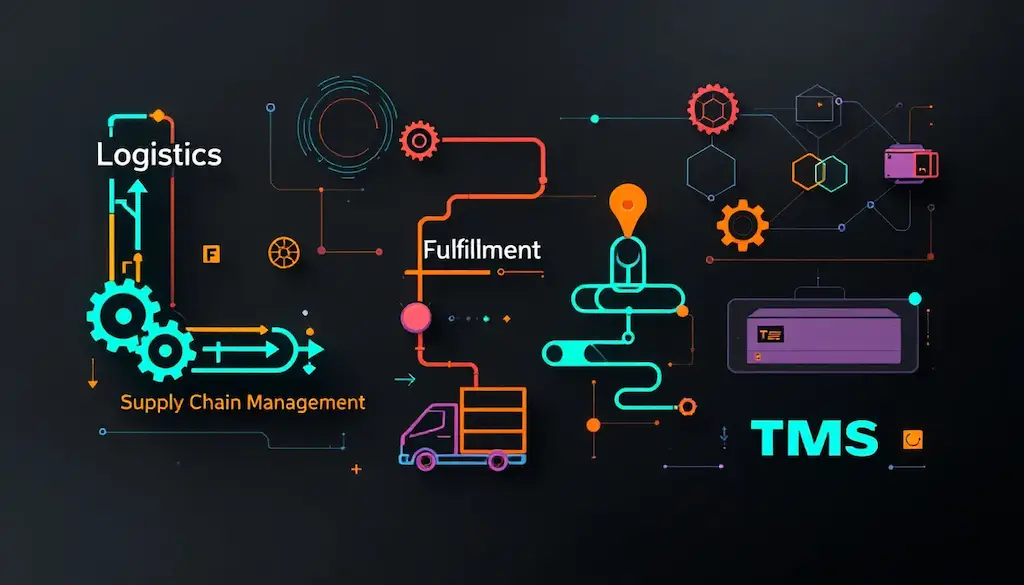Need to decode ecommerce abbreviations? This ecommerce glossary covers the most important terms to help you communicate efficiently and manage your online business better…
Key Takeaways
- Ecommerce abbreviations like AOV, CAC, and CLV simplify communication and enhance operational efficiency, enabling professionals to navigate the industry’s complexities.
- Key metrics such as Conversion Rate (CR) and Net Promoter Score (NPS) are crucial for understanding customer behavior and improving sales and retention strategies.
- Utilizing technology tools like CMS, SaaS, and APIs streamlines operations and enhances the customer experience, vital for successful ecommerce management.
Understanding Ecommerce Abbreviations
Ecommerce abbreviations are the unsung heroes of the online sales sector. They streamline communication and enhance operational efficiency, making it easier for professionals to navigate the complex world of ecommerce. These abbreviations save time and enhance the clarity of business discussions by simplifying complex terms.
Imagine trying to explain the concept of Customer Lifetime Value (CLV) every time you mention it. Abbreviations like CLV make communication faster and more effective. They serve as a shorthand that conveys complex ideas concisely, allowing for more efficient strategic planning and logistics management in ecommerce businesses.
A cheat sheet or flashcards for these acronyms can be incredibly helpful. This not only aids in quick reference but also ensures that everyone in your team is on the same page. Understanding ecommerce abbreviations is not just about keeping up with industry jargon; it’s about enhancing your ability to run a successful ecommerce store.
Commonly Used Ecommerce Abbreviations
Grasping commonly used ecommerce abbreviations is crucial for anyone in the ecommerce industry.
These abbreviations, such as:
- D2C (Direct to Consumer)
- POS (Point of Sale)
- B2C (Business-to-Consumer)
- CPA (Cost Per Action)
play a significant role in streamlining communication and enhancing operational efficiency. They help professionals communicate effectively, making it easier to navigate the ecommerce landscape and improve business performance.
Some specific abbreviations frequently used in the ecommerce world include AOV, CAC, and CLV. These terms are pivotal in understanding customer behavior and optimizing your marketing strategies.
AOV (Average Order Value)
AOV, or Average Order Value, is a crucial metric in the ecommerce world that indicates the average spending per order. Calculating AOV is straightforward: simply divide your total revenue by the number of orders. This metric is essential for ecommerce businesses because it provides insight into customer spending behavior and helps in evaluating product pricing and channel performance.
Increasing your AOV should be a priority as it directly impacts your revenue and profitability. Techniques such as cross-selling, upselling, and offering bundle deals can effectively boost your AOV. Optimizing this metric helps in making informed decisions to enhance your overall business strategy.
Including AOV in your web shop analysis enables assessment of advertising potential and seasonality effects, offering a comprehensive view of your ecommerce store’s performance. This metric is not just a number; it’s a powerful tool for driving growth and profitability.
CAC (Customer Acquisition Cost)
CAC, or Customer Acquisition Cost, is another vital metric that ecommerce businesses need to monitor closely. It represents the total cost associated with acquiring a new customer, including expenses for warehousing, fulfillment, marketing, and labor. Understanding CAC is crucial as it allows you to evaluate the effectiveness of your marketing strategies and determine the return on investment (ROI) for your marketing spend.
To calculate CAC, sum up all the costs involved in acquiring customers and divide by the number of new customers acquired during a specific period. This metric helps businesses understand how much they are spending to attract each customer and whether these efforts are profitable. Comparing CAC with Customer Lifetime Value (CLV) informs decisions about marketing budgets and strategies.
Lowering CAC while maintaining or improving customer acquisition rates can significantly boost profitability. This requires a strategic approach to marketing and customer engagement, ensuring that you are getting the most out of your advertising spend.
CLV (Customer Lifetime Value)
CLV, or Customer Lifetime Value, is a metric that predicts the total gross profit from a single customer over their entire relationship with your business. This metric is essential for planning marketing budgets and strategies, particularly in terms of customer retention. Understanding CLV helps businesses decide how much to invest in acquiring new customers and retaining existing ones.
Calculating CLV involves considering various costs, including returns, acquisition costs, and service costs related to the customer. This metric helps predict the net profit from the entire future relationship with a customer, providing valuable insights for long-term business planning.
Including CLV in your marketing strategy helps focus on high-value customers, tailoring efforts to enhance their experience and maximize profitability. It’s not just about acquiring customers; it’s about building lasting relationships that drive sustained growth.
Marketing and Advertising Abbreviations
Marketing and advertising are the lifeblood of any ecommerce business. Understanding abbreviations like PPC, SEO, and SEM is crucial for developing effective marketing campaigns and optimizing your advertising spend. These terms simplify complex marketing concepts, making it easier to communicate your strategies and measure their success.
Understanding PPC, SEO, and SEM can boost your marketing efforts and drive online sales.
PPC (Pay-Per-Click)
PPC, or Pay-Per-Click, is a popular advertising model. In this model, advertisers are charged every time a user clicks on their ad. This performance-based approach allows for precise budgeting and measurement of advertising effectiveness. Cost per click (CPC) is the amount spent to receive a click on an advertisement within a PPC campaign.
PPC campaigns are essential for driving targeted traffic to your website and achieving specific marketing goals. Platforms like Google Ads are popular for PPC campaigns, allowing businesses to bid on keywords and appear in search engine results pages (SERPs). The impact of PPC on ad spend is significant as it provides advertisers with control over their costs based on how their ads perform.
Leveraging PPC helps reach your target audience more effectively and achieve higher ROI from digital marketing efforts.
SEO (Search Engine Optimization)
SEO, or Search Engine Optimization, is the process of optimizing a website to enhance its organic search ranking. The goal of SEO is to rank higher in search engine results and increase organic web traffic. This involves selecting the right keywords, phrases, and media to attract and engage your target audience.
On-page optimization, a primary discipline of SEO, focuses on improving individual web pages to enhance ranking. This includes optimizing meta tags, headers, content, and images to ensure they are search-engine friendly. Effective SEO strategies can significantly boost your website’s visibility, driving more traffic and potential customers to your online store.
Investing in SEO is crucial for long-term success in the ecommerce industry. It helps you stay competitive and ensures that your website remains relevant and accessible to your audience.
SEM (Search Engine Marketing)
SEM, or Search Engine Marketing, involves promoting websites by increasing their visibility in search engine results pages through paid advertisements. Unlike SEO, which focuses on organic rankings, SEM primarily involves paid search strategies. This includes using specific keywords and phrases to target audiences in ads, enhancing visibility and driving targeted traffic to your site.
SEM is a powerful tool for ecommerce businesses looking to boost their online presence quickly. By investing in SEM, you can achieve immediate visibility in search engines, attracting potential customers who are actively searching for products or services like yours.
Combining SEM with SEO can create a comprehensive search engine strategy that maximizes your reach and drives sustained growth.
Sales and Customer Metrics Abbreviations
Understanding abbreviations related to sales and customer metrics is crucial for efficiently managing ecommerce operations. These metrics provide insights into customer behavior, helping you tailor your strategies to improve sales performance and customer satisfaction.
Let’s explore some key sales and customer metrics abbreviations, such as CR, NPS, and CTR, and understand their significance in the ecommerce landscape.
CR (Conversion Rate)
CR, or Conversion Rate, is a critical metric that measures the percentage of prospective customers who take the desired action, such as making a purchase or filling out a form. A high conversion rate shows that marketing efforts are successful. It also reflects the effectiveness of the web design.
Conversion Rate is typically calculated as the ratio of visitors to buyers or form submissions. Traffic quality, usability, product and service offerings, and pricing are all important factors. They have a significant impact on the conversion rate. By optimizing these factors, you can improve your conversion rate and, consequently, your sales and profitability.
Conversion Rate Optimization (CRO) involves using techniques like A/B testing to measure and enhance the effectiveness of your marketing initiatives. This continuous improvement process ensures that your ecommerce store remains competitive and profitable.
NPS (Net Promoter Score)
NPS, or Net Promoter Score, is a metric that helps businesses understand customer loyalty by measuring how likely customers are to recommend their products to others. This score is calculated by asking customers a simple question: “On a scale from 0 to 10, how likely are you to recommend our products to a friend or colleague?”.
NPS is significant as it provides insights into customer loyalty and satisfaction, allowing businesses to identify areas for improvement and enhance customer retention strategies. A high NPS indicates strong customer loyalty, which is crucial for long-term business success.
By regularly monitoring NPS, you can gauge customer sentiment and take proactive steps to address any issues, ensuring that your customers remain satisfied and loyal.
CTR (Click Through Rate)
CTR, or Click Through Rate, is an important metric used to evaluate the performance of advertisements and marketing campaigns. It is defined as the ratio between views and clicks on an advertisement, providing insights into how well your ads are engaging users.
A higher CTR indicates that your ads are effectively capturing the attention of your audience, signaling successful advertising strategies. This metric is crucial for measuring engagement with digital ads and assessing the effectiveness of your digital advertising campaign and marketing efforts.
By analyzing CTR, you can identify which ads are performing well and make data-driven decisions to optimize your advertising campaigns for better results.
Technology and Platform Abbreviations
Technology and platforms are the backbone of any successful ecommerce business. Understanding abbreviations like CMS, SaaS, and API is essential for leveraging these tools to streamline operations and enhance customer experience.
Let’s explore these key technology and platform abbreviations and understand their relevance in the ecommerce industry.
CMS (Content Management System)
CMS, or Content Management System, is a software system for creating, managing, and publishing digital content. CMS platforms enable users to create and manage website content without extensive technical knowledge. WordPress, Joomla!, Drupal, Typo3, and Graph CMS are among the popular CMS tools available. These platforms are widely used for content management. These platforms provide a user-friendly interface and powerful features that allow businesses to maintain their online presence effectively.
Using a CMS ensures your website remains up-to-date and engaging, providing a seamless experience for visitors.
SaaS (Software as a Service)
SaaS, or Software-as-a-Service, is a software tool that is licensed and accessed online. SaaS products are typically provided as cloud-based subscriptions, allowing users to access the latest features and updates automatically. Examples of SaaS solutions include email service providers, CRM systems, and marketing automation tools.
These solutions offer flexibility, scalability, and cost-effectiveness, making them ideal for ecommerce businesses. Leveraging SaaS tools streamlines operations, improves efficiency, and allows focus on business growth.
API (Application Programming Interface)
An API, which stands for Application Programming Interface, consists of a collection of protocols and tools. These are used for developing software applications and facilitating their connections. APIs allow different software applications to communicate and interact with each other, enabling seamless integration.
In ecommerce, APIs are used to connect various systems, such as payment gateways, inventory management, and shipping solutions. This integration ensures that data flows smoothly between systems, enhancing efficiency and reducing manual work.
By utilizing APIs, you can extend the functionalities of your existing software applications and create a more cohesive and efficient ecommerce ecosystem.
Logistics and Fulfillment Abbreviations
Logistics and fulfillment are critical components of any ecommerce business. Understanding abbreviations like 3PL, WMS, and FBA is essential for managing your supply chain effectively.
Let’s delve into these key logistics and fulfillment abbreviations and understand their importance in the ecommerce landscape.
3PL (Third Party Logistics)
3PL, or Third-Party Logistics, refers to outsourcing business processes related to order fulfillment and supply chain management. 3PLs offer services such as storage, order processing, fast shipping, and returns processing.
Using 3PLs can lead to advantages such as reduced processing and storage fees, fast order fulfillment, and enhanced customer service. By outsourcing these functions, ecommerce businesses can focus on their core operations and scale their business more efficiently.
3PLs play a crucial role in ensuring that your products are delivered to customers quickly and accurately, enhancing customer satisfaction and loyalty.
WMS (Warehouse Management System)
WMS, or Warehouse Management System, is a software tool that manages inventory and supply chain operations. A WMS devises and implements scalable workflows for inventory management, ensuring that stock keeping unit levels are optimized and orders are fulfilled efficiently.
A critical component for the success of a 2PL model is the Warehouse Management System (WMS). By using a WMS, businesses can automate various warehouse processes, reducing manual errors and improving overall efficiency.
A WMS significantly enhances supply chain management, ensuring accurate and prompt storage, picking, packing, and shipping of products.
FBA (Fulfillment by Amazon)
FBA, or Fulfillment by Amazon, allows sellers to delegate order processing and inventory management to Amazon. Sellers in the FBA program are responsible for shipping inventory to Amazon Fulfillment Centers, where Amazon handles the rest of the process.
FBA sellers receive Prime Two-Day Shipping tags for their listings, which can significantly boost visibility and sales. Leveraging Amazon’s logistics network allows third-party sellers to achieve faster order fulfillment and enhanced customer service.
FBA is an excellent option for ecommerce businesses looking to scale quickly and efficiently, leveraging Amazon’s robust infrastructure to reach a broader audience.
Financial and Operational Abbreviations
Financial and operational abbreviations play a crucial role in simplifying complex financial concepts for ecommerce professionals. Understanding these abbreviations is essential for assessing business performance, calculating profits, and streamlining financial reporting.
Let’s explore some key financial and operational abbreviations, such as COGS, P&L, and MRR, and understand their importance in ecommerce.
COGS (Cost of Goods Sold)
COGS, or Cost of Goods Sold, represents the total expenses incurred in the production of goods sold by a business. This includes the cost of materials and labor involved in production. High COGS can significantly impact a company’s profitability by reducing its gross margin. Monitoring and managing COGS helps businesses identify cost reduction areas and improve overall profitability.
Understanding COGS is essential for pricing strategies, inventory management, and financial planning, ensuring that your ecommerce business remains profitable and competitive.
P&L (Profit and Loss)
P&L, or Profit and Loss, represents a profit-and-loss account comparing expenses and income over a specific period. The purpose of a P&L statement is to summarize income and expenses, providing insights into the financial health of a business.
A positive P&L indicates a profitable sale, while a negative P&L suggests that expenses have exceeded income. Regularly reviewing P&L statements allows businesses to make informed decisions to improve profitability and ensure long-term success.
Understanding P&L is crucial for financial planning, budgeting, and performance evaluation, helping businesses stay on track with their financial goals.
MRR (Monthly Recurring Revenue)
MRR, or Monthly Recurring Revenue, is a metric that projects the expected revenue on a recurring basis over a month. This metric is particularly important for subscription-based businesses, providing insights into revenue stability and growth potential.
Tracking MRR helps businesses forecast future revenue, plan for growth, and make informed decisions about marketing and customer retention strategies. Understanding MRR is crucial for maintaining a steady cash flow and ensuring the long-term sustainability of your ecommerce business.
MRR helps businesses identify trends, evaluate the success of their subscription models, and optimize their revenue generation strategies.
Customer Relationship Management Abbreviations
Customer Relationship Management (CRM) abbreviations are essential for managing customer relationships and enhancing customer experience. Understanding these abbreviations helps businesses improve customer satisfaction, loyalty, and engagement.
Let’s explore some key CRM abbreviations, such as CRM, CX, and RFM, and understand their significance in the ecommerce industry.
CRM (Customer Relationship Management)
CRM, or Customer Relationship Management, refers to systems and strategies used to manage customer details and enhance service delivery. CRM systems support ecommerce growth by improving customer service and fostering repeat business.
Examples of CRM software include Hubspot, Salesforce, and Sellercloud’s Memaila. These systems help businesses automate repetitive tasks, allowing sales teams to focus on relationship-building and customer engagement.
Leveraging CRM systems allows ecommerce businesses to maintain detailed records of customer interactions, tailor marketing efforts, and provide personalized experiences that drive customer loyalty.
CX (Customer Experience)
CX, or Customer Experience, refers to the overall perception of a brand, product, or service from initial contact to post-purchase. This includes the entire shopping experience, from browsing the website to receiving customer support.
A positive CX is crucial for building customer loyalty and driving repeat business. Focusing on customer experience helps businesses identify areas for improvement and ensures customers’ needs are met and problems are solved.
Investing in CX initiatives can significantly enhance customer satisfaction and loyalty, ensuring long-term success for your ecommerce business.
RFM (Recency, Frequency, Monetary)
RFM analysis segments customers based on their purchasing behavior, focusing on how recently they purchased, how often they purchase, and how much they spend. This analysis helps businesses identify their most valuable customers and tailor their marketing efforts accordingly.
Utilizing RFM analysis helps ecommerce businesses create targeted marketing campaigns that resonate with high-value customers, driving engagement and loyalty. This approach ensures that marketing resources are used effectively, maximizing ROI and profitability.
RFM analysis is a powerful tool for understanding customer behavior and optimizing your marketing strategies to achieve better results.
Digital Marketing and Analytics Abbreviations
Digital marketing and analytics are critical for tracking and improving marketing efforts. Understanding abbreviations like GA, KPI, and ORM is essential for measuring performance and making data-driven decisions.
Let’s explore these key digital marketing and analytics abbreviations and understand their relevance in the ecommerce industry.
GA (Google Analytics)
GA, or Google Analytics, is a powerful tool for analyzing website traffic and providing insights about visitors. Google Analytics tracks user interactions to help businesses understand their audience better and improve their website’s effectiveness.
By using Google Analytics, ecommerce businesses can monitor metrics such as bounce rate, user behavior, and conversion rates, providing actionable insights for enhancing user experience.
Utilizing Google Analytics is crucial for optimizing your website to meet visitors’ needs, driving engagement and sales.
KPI (Key Performance Indicator)
KPI, or Key Performance Indicator, is a metric used to measure specific aspects of business performance. KPIs are crucial for assessing business success and can provide valuable insights into areas that need improvement. Effective KPIs are actionable metrics that enhance profitability and guide strategic decision-making.
Regularly monitoring KPIs ensures businesses are on track to achieve their goals and make informed decisions to drive growth. Understanding and utilizing KPIs is essential for measuring the success of your marketing efforts and ensuring long-term sustainability.
ORM (Online Reputation Management)
ORM, or Online Reputation Management, involves managing and influencing the perception of a brand or business online. This includes monitoring and responding to customer reviews, social media interactions, and other online content that can impact your reputation.
Effective ORM strategies can help businesses maintain a positive online presence, build trust with customers, and drive engagement. Proactively managing your online reputation ensures your brand remains credible and attractive to potential customers.
Investing in ORM is crucial for protecting your brand’s image and ensuring long-term success in the ecommerce industry.
Summary
In conclusion, understanding ecommerce abbreviations is essential for navigating the complex world of online business. These abbreviations streamline communication, enhance operational efficiency, and provide valuable insights into various aspects of ecommerce.
By familiarizing yourself with key abbreviations like AOV, CAC, CLV, PPC, SEO, and more, you can make informed decisions that drive growth and profitability. Embracing these terms as part of your daily business operations will equip you to stay competitive and succeed in the ever-evolving ecommerce landscape.
Ready to simplify your ecommerce operations?
SphereWMS can help you streamline warehouse management, improve order accuracy, and enhance customer satisfaction by integrating seamlessly with your ecommerce platforms. Contact us today to discover how our powerful WMS solution can optimize your logistics and fulfillment processes.
Frequently Asked Questions
What is AOV and why is it important?
AOV, or Average Order Value, is crucial because it reveals how much customers typically spend per order, allowing businesses to enhance their pricing strategies and better understand shopping habits. By focusing on increasing AOV, you can boost your overall revenue effectively.
How is CAC calculated?
To calculate CAC, just add up all your costs for acquiring customers and divide that total by the number of new customers you gained. It’s that simple!
What is the difference between SEO and SEM?
SEO is all about improving your website to rank higher in organic search results, while SEM uses paid ads to boost visibility. So, if you’re looking to attract traffic without spending, SEO is your go-to; for quicker visibility, SEM might be the way to go.
What is the role of a WMS in ecommerce?
A WMS plays a crucial role in eCommerce by streamlining inventory and supply chain operations, which leads to faster order fulfillment and better stock management. This efficiency ultimately enhances your customers’ shopping experience.
Why is NPS important for ecommerce businesses?
NPS is crucial for ecommerce businesses because it gauges customer loyalty and satisfaction, allowing you to enhance retention and pinpoint improvements. Understanding your NPS can lead to stronger relationships with your customers.









